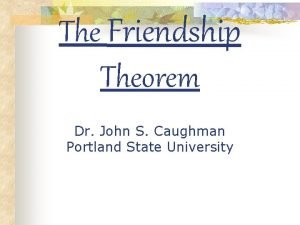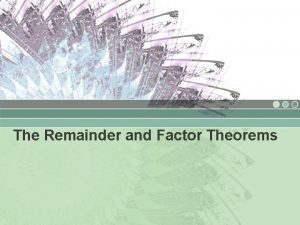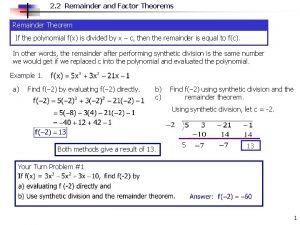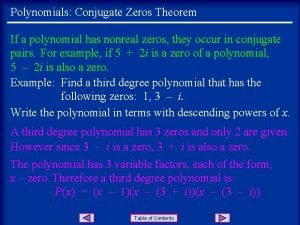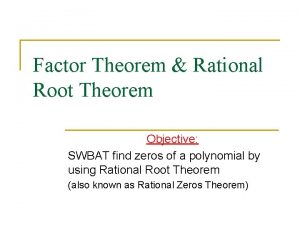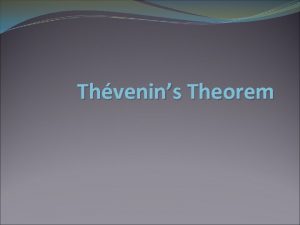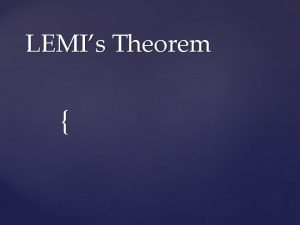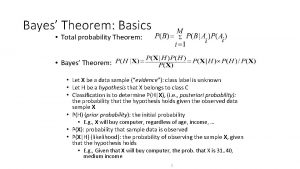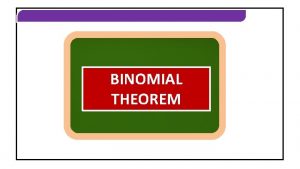The Friendship Theorem Dr John S Caughman Portland




















































































- Slides: 84

The Friendship Theorem Dr. John S. Caughman Portland State University

Public Service Announcement “Freshman’s Dream” (a+b)p=ap+bp …mod p …when a, b are integers …and p is prime.

Freshman’s Dream Generalizes! (a 1+a 2+…+an)p=a 1 p +a 2 p +…+anp …mod p …when a, b are integers …and p is prime.

Freshman’s Dream Generalizes A= a 1 0 0 0 * a 2 0 0 * * a 3 0 * * * a 4 (a 1+a 2+…+an)p = a 1 p +a 2 p +…+anp tr(A) p = tr(Ap) (mod p)

Freshman’s Dream Generalizes! A= * * * * tr(A) p = tr(Ap) (mod p) tr(A p) = tr((L+U)p) = tr(Lp +Up) = tr(Lp)+tr(Up)=0+tr(U)p = tr(A)p Note: tr(UL)=tr(LU) so cross terms combine , and coefficients =0 mod p.

The Theorem If every pair of people at a party has precisely one common friend, then there must be a person who is everybody's friend.

Cheap Example Nancy John Mark

Cheap Example of a Graph Nancy John Mark

What a Graph IS: Nancy John Mark

What a Graph IS: Nancy John Vertices! Mark

What a Graph IS: Nancy John Edges! Mark

What a Graph IS NOT: Nancy John Mark

What a Graph IS NOT: Nancy John Loops! Mark

What a Graph IS NOT: Nancy John Loops! Mark

What a Graph IS NOT: Nancy John Directed edges! Mark

What a Graph IS NOT: Nancy John Directed edges! Mark

What a Graph IS NOT: Nancy John Multi-edges! Mark

What a Graph IS NOT: Nancy John Multi-edges! Mark

‘Simple’ Graphs… Nancy John • Finite • Undirected • No Loops • No Multiple Edges Mark

The Theorem, Restated Let G be a simple graph with n vertices. If every pair of vertices in G has precisely one common neighbor, then G has a vertex with n-1 neighbors.

The Theorem, Restated Generally attributed to Erdős (1966). Easily proved using linear algebra. Combinatorial proofs more elusive.

NOT A TYPICAL “THRESHOLD” RESULT

Pigeonhole Principle If more than n pigeons are placed into n or fewer holes, then at least one hole will contain more than one pigeon.

Some threshold results If a graph with n vertices has > n 2/4 edges, then there must be a set of 3 mutual neighbors. If it has > n(n-2)/2 edges, then there must be a vertex with n-1 neighbors.

Extremal Graph Theory If this were an extremal problem, we would expect graphs with MORE edges than ours to also satisfy the same conclusion…





1

1 2

1 2 3

1 4 2 3

4

4

4

2

Of the 15 pairs, 3 have four neighbors in common and 12 have two in common. So ALL pairs have at least one in common. But NO vertex has five neighbors!

Related Fact – losing edges

Related Fact – losing edges

Related Fact – losing edges

Summary If every pair of vertices in a graph has at least one neighbor in common, it might not be possible to remove edges and produce a subgraph in which every pair has exactly one common neighbor.

Accolades for Friendship n The Friendship Theorem is listed among Abad's “ 100 Greatest Theorems” n The proof is immortalized in Aigner and Ziegler's Proofs from THE BOOK.

Example 1

Example 2

Example 3

How to prove it: STEP ONE: If x and y are not neighbors, they have the same # of neighbors. Why: Let Nx = set of neighbors of x Let Ny = set of neighbors of y

How to prove it: x y

How to prove it: y x Nx

How to prove it: y x Ny

How to prove it: x y For each u in Nx define: f(u) = common neighbor of u and y.

How to proveu it: 1 x Pick u 1 in Nx. y

How to proveu it: 1 x f(u 1) y f(u 1) = common neighbor of u 1 and y.

How to prove it: x y

How to prove it: x u 2 Pick u 2 in Nx. y

How to prove it: x u 2 f(u 2) y f(u 2) = common neighbor of u 2 and y.

How to prove it: x y

How to prove it: u x u* f(u)= f(u*) y

How to prove it: u x u* f(u)= f(u*) y

How to prove it: u x u* f(u)= f(u*) y So f is one-to-one from Nx to Ny.

How to prove it: u x u* f(u)= f(u*) y So f is one-to-one from Nx to Ny. So it can’t be true that |Nx| > |Ny|.

How to prove it: u x u* f(u)= f(u*) y So f is one-to-one from Nx to Ny. So it can’t be true that |Nx| > |Ny|. So |Nx| = |Ny|.

How to prove it: STEP 1: If x and y are not neighbors, they have the same # of neighbors. STEP 2: Either some x has n-1 neighbors or ALL vertices have same # of neighbors. Why: Assume no vertex has n-1 neighbors. Let A = {x : x has max # of neighbors, k}. B = {y : y has < k neighbors}.

A = {x : x has max # of neighbors, k}. B = {y : y has < k neighbors}. By Step 1, all in A are neighbors to all in B! Set || Possible Size A 0, 1, 2, …. , n B 0, 1, 2, …. , n .

How to prove it: STEP 1: If x and y are not neighbors, they have the same # of neighbors. STEP 2: Either some x has n-1 neighbors or ALL vertices have k neighbors. STEP 3: If all vertices have k neighbors, then n = k (k-1) + 1.

How to prove it: STEP 3: If all vertices have k neighbors, then n = k (k-1) + 1. Why: Count paths of length 2…

How to prove it: STEP 3: If all vertices have k neighbors, then n = k (k-1) + 1. Why: Count paths of length 2… (2 ) n

How to prove it: STEP 3: If all vertices have k neighbors, then n = k (k-1) + 1. Why: Count paths of length 2… (2 ) n 1

How to prove it: STEP 3: If all vertices have k neighbors, then n = k (k-1) + 1. Why: Count paths of length 2… (2 ) n 1 =

How to prove it: STEP 3: If all vertices have k neighbors, then n = k (k-1) + 1. Why: Count paths of length 2… (2 ) n 1 = n

How to prove it: STEP 3: If all vertices have k neighbors, then n = k (k-1) + 1. Why: Count paths of length 2… (2 ) n 1 = n (k)

How to prove it: STEP 3: If all vertices have k neighbors, then n = k (k-1) + 1. Why: Count paths of length 2… (2 ) n 1 = n (k) (k-1)

How to prove it: STEP 3: If all vertices have k neighbors, then n = k (k-1) + 1. Why: Count paths of length 2… (2 ) n n (k) (k-1) 1 = ____ 2

How to prove it: STEP 3: If all vertices have k neighbors, then n = k (k-1) + 1. ( ) n n (k) (k-1) 1 = ____ 2 2 n (k) (k-1) (n)(n-1) = ____ 2 2 n = k (k-1) + 1

How to prove it: STEP 1: If x and y are not neighbors, they have the same # of neighbors. STEP 2: Either some x has n-1 neighbors or ALL vertices have k neighbors. STEP 3: If all vertices have k neighbors, then n = k (k-1) + 1.

The Master Plan Each pair has 1 in common Some x has n-1 neighbors If x, y not neighbors, |Nx|=|Ny| Either Or ? Some Linear Algebra |Nx|= k for all x, and n =k(k-1)+1

Adjacency Matrix Call vertices v 1, v 2, …, vn. Let A = n x n matrix where: Aij = 1, if vi, vj are neighbors, Aij = 0, if not. A is called the adjacency matrix of G. { Notice that the trace of A is 0.

Adjacency Matrix v 1 v 4 v 2 0 1 1 1 A= v 3 A 2 = 0 1 1 1 1 0 1 0 1 1 0 1 0 1 0 = 1 1 0 1 0 3 1 2 1 2 2 1 3 1 1 2

Adjacency Matrix (A 2) ij = # common neighbors of vi, vj So……. . for our graphs…. . (A 2) ij = 1 (A 2) ij = k if i, j different, and if i = j. A 2 = (k-1) I + J. (J = all 1’s matrix)

Adjacency Matrix A 2 = (k-1) I + J (J = all 1’s matrix) A J = (k) J Now let p be a prime divisor of k-1. Then k = 1 and n = k(k-1)+1 = 1 (mod p) So A 2 = J, and A J = J. (mod p) Therefore, Ai = J for all i > 1. (mod p)

Adjacency Matrix Ai = J But for all i > 1 (mod p) tr Ap = (tr A)p (mod p) So, modulo p, we get: 1 = n = tr J = tr Ap = (tr A)p = 0.

Putting it all together Each pair has 1 in common Some x has n-1 neighbors If x, y not neighbors, 0=1 |Nx|=|Ny| Either Or |Nx|= k for all x and n =k(k-1)+1

Moral: To make progress in almost any field of math, find a way to sneak linear algebra into it !

THANK YOU !
 Caughman road elementary school
Caughman road elementary school Relation between green's theorem and stokes' theorem
Relation between green's theorem and stokes' theorem The friendship theorem
The friendship theorem Angela surbrize
Angela surbrize What is factor theorem
What is factor theorem Factor theroum
Factor theroum Factor theorem and remainder theorem
Factor theorem and remainder theorem Conjugate theorem
Conjugate theorem Rational zeros theorem
Rational zeros theorem Linear factors theorem and conjugate zeros theorem
Linear factors theorem and conjugate zeros theorem Hình ảnh bộ gõ cơ thể búng tay
Hình ảnh bộ gõ cơ thể búng tay Bổ thể
Bổ thể Tỉ lệ cơ thể trẻ em
Tỉ lệ cơ thể trẻ em Gấu đi như thế nào
Gấu đi như thế nào Chụp phim tư thế worms-breton
Chụp phim tư thế worms-breton Hát lên người ơi alleluia
Hát lên người ơi alleluia Các môn thể thao bắt đầu bằng tiếng đua
Các môn thể thao bắt đầu bằng tiếng đua Thế nào là hệ số cao nhất
Thế nào là hệ số cao nhất Các châu lục và đại dương trên thế giới
Các châu lục và đại dương trên thế giới Công thức tiính động năng
Công thức tiính động năng Trời xanh đây là của chúng ta thể thơ
Trời xanh đây là của chúng ta thể thơ Mật thư anh em như thể tay chân
Mật thư anh em như thể tay chân 101012 bằng
101012 bằng Phản ứng thế ankan
Phản ứng thế ankan Các châu lục và đại dương trên thế giới
Các châu lục và đại dương trên thế giới Thể thơ truyền thống
Thể thơ truyền thống Quá trình desamine hóa có thể tạo ra
Quá trình desamine hóa có thể tạo ra Một số thể thơ truyền thống
Một số thể thơ truyền thống Cái miệng bé xinh thế chỉ nói điều hay thôi
Cái miệng bé xinh thế chỉ nói điều hay thôi Vẽ hình chiếu vuông góc của vật thể sau
Vẽ hình chiếu vuông góc của vật thể sau Biện pháp chống mỏi cơ
Biện pháp chống mỏi cơ đặc điểm cơ thể của người tối cổ
đặc điểm cơ thể của người tối cổ V cc
V cc Vẽ hình chiếu đứng bằng cạnh của vật thể
Vẽ hình chiếu đứng bằng cạnh của vật thể Fecboak
Fecboak Thẻ vin
Thẻ vin đại từ thay thế
đại từ thay thế điện thế nghỉ
điện thế nghỉ Tư thế ngồi viết
Tư thế ngồi viết Diễn thế sinh thái là
Diễn thế sinh thái là Dot
Dot Số nguyên tố là
Số nguyên tố là Tư thế ngồi viết
Tư thế ngồi viết Lời thề hippocrates
Lời thề hippocrates Thiếu nhi thế giới liên hoan
Thiếu nhi thế giới liên hoan ưu thế lai là gì
ưu thế lai là gì Hổ đẻ mỗi lứa mấy con
Hổ đẻ mỗi lứa mấy con Sự nuôi và dạy con của hổ
Sự nuôi và dạy con của hổ Sơ đồ cơ thể người
Sơ đồ cơ thể người Từ ngữ thể hiện lòng nhân hậu
Từ ngữ thể hiện lòng nhân hậu Thế nào là mạng điện lắp đặt kiểu nổi
Thế nào là mạng điện lắp đặt kiểu nổi Portland
Portland Portland state university undergraduate tuition and fees
Portland state university undergraduate tuition and fees Portland japantown
Portland japantown Manufacture of portland cement
Manufacture of portland cement Flights to honoré de balzac tram stop
Flights to honoré de balzac tram stop Hard rock cafe portland maine
Hard rock cafe portland maine Portland colocation
Portland colocation Clinker cemento
Clinker cemento Burnside triangle
Burnside triangle Composição do cimento portland
Composição do cimento portland Bruce whitman portland
Bruce whitman portland Shac portland state
Shac portland state Scortportland
Scortportland Dhhs portland maine
Dhhs portland maine Ihs portland
Ihs portland East portland chamber of commerce
East portland chamber of commerce Portland stormwater management manual
Portland stormwater management manual Human environment interaction in portland oregon
Human environment interaction in portland oregon Scort jacksonville
Scort jacksonville Portland water bureau
Portland water bureau Jetreports download
Jetreports download Twelvefold portland
Twelvefold portland Portland design commission
Portland design commission Spray rack training
Spray rack training Residential blowers portland
Residential blowers portland Cbg monitoring sheet
Cbg monitoring sheet Pmi portland
Pmi portland Reem murad
Reem murad Portland cement definition
Portland cement definition Portland high school graduation 2021
Portland high school graduation 2021 Portland general electric irp
Portland general electric irp Portland trip planner
Portland trip planner Graypdx
Graypdx


